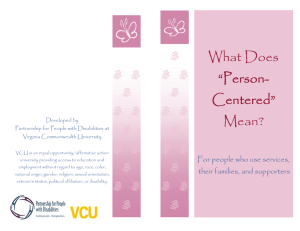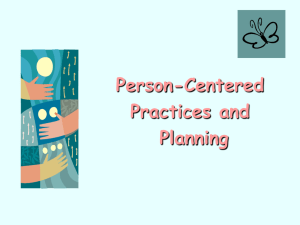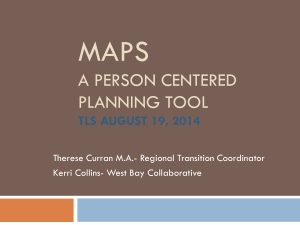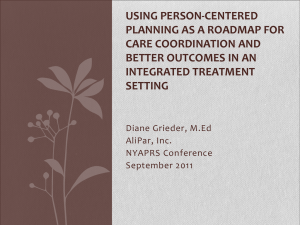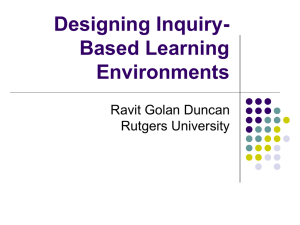Robyn Stone Culture Change to Person Centered Care
advertisement
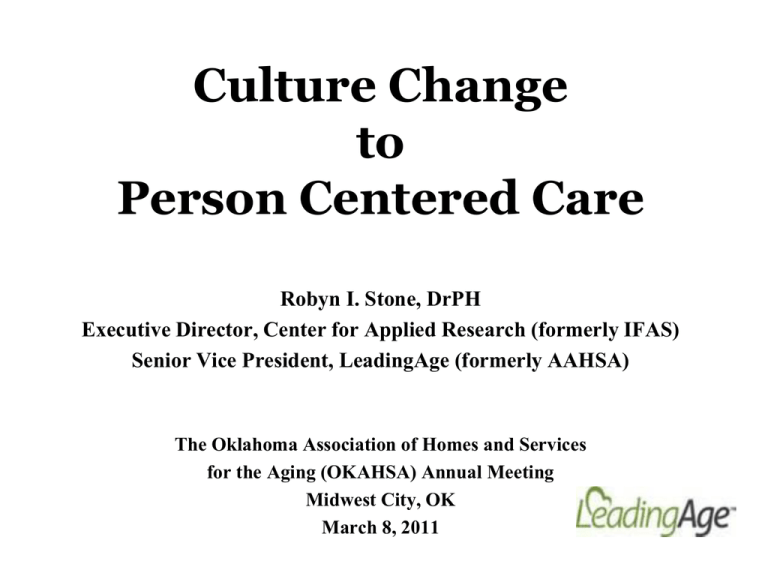
Culture Change to Person Centered Care Robyn I. Stone, DrPH Executive Director, Center for Applied Research (formerly IFAS) Senior Vice President, LeadingAge (formerly AAHSA) The Oklahoma Association of Homes and Services for the Aging (OKAHSA) Annual Meeting Midwest City, OK March 8, 2011 Three Inter-Related Areas of Activity PersonCentered Care Continuous Quality Improvement Workforce Improvement What is Person Centered Care? "Culture change" is the common name given to the national movement for the transformation of older adult services, based on person-directed values and practices where the voices of elders and those working with them are considered and respected. Core person-directed values are choice, dignity, respect, self-determination and purposeful living. -Pioneer Network What is Person Centered Care? Person centered care is a philosophy of care that requires thinking about and planning with and for people who require assistance in their daily lives and providing that assistance in such a way that the person is honored and valued and is not lost in the tasks of care giving. The emphasis of care is on wellbeing and quality of life as defined by the person. -Better Jobs Better Care, Institute for the Future of Aging Services, AAHSA How is Person Centered Care Different? A person centered care approach acknowledges and accepts each resident as a whole person, and provides moral and ethical development of staff. Person centered care can transform the work place into a positive enriching social and learning environment that enhances the quality of life for staff, residents and family/support system. Culture • The uniqueness of an organization or an institution • Its “personality” • The way an organization/institution does things • The values, the lifestyle, the goals which are peculiar to an organization or an institution A Thought I've learned that people will forget what you said, people will forget what you did, but people will never forget how you made them feel. -Maya Angelou It’s all about…..Relationships Relationships People who had close relationships with their caregivers retained more mind and brain function over time than people who were not close to their caregivers. It is unclear why – further research is planned – but closer caregivers may provide better supportive and overall health care. Also, Alzheimer’s patients whose caregivers feel closer to them may be less prone to depression and have a better quality of life. -Constantine Lyketsos, MD, MHS, Elizabeth Plan Althouse Professor in Alzheimer’s Disease Research and director, Johns Hopkins Memory and Alzheimer’s Treatment Center Person Centered Community A person centered community is a place where: residents want to live personnel want to work both choose to stay Person Centered Communities Person centered communities foster a culture that supports: Autonomy Diversity Individual choice Person Centered Communities •Leadership: cultivates relationships among residents, families/support systems, and personnel commits to responsiveness, spontaneity, and continuous learning and growth. •Residents and Personnel: celebrate the cycles of life connect to the local community continue relationships nurture the quality of everyday life Person Centered Communities • Residents: experts regarding life in their home participate in deciding about: • rhythm of their day • services provided • issues that are important to them family/support systems are welcomed Person Centered Communities • Personnel: partner with residents and their families/support systems understand: • what services residents want • how the services should be delivered • how they can help in their home Elements of Person Centered Care • • • • • • Personhood Knowing the person Maximizing choice and autonomy Quality care Nurturing relationships Support physical and organizational environment Stage Model of Culture Change in Nursing Homes I. Institutional Model II. Transformational Model III. Neighborhood Model IV. Household Model Leslie Grant and Laverne Norton Changes in ResidentDirected Decision Making • More dependent on group process • Decisional control more resident-centered • Input is real, not symbolic Changes in Staffing Roles • Staff assignment becomes more permanent and consistent • Staff works autonomously in smaller multidisciplinary work teams • Hierarchical structure is flattened • Cross-trained staff with blended roles • Universal worker Changes in Physical Environment • • • • Size of functional areas become smaller More personalized and self-contained Common dining room for household Elimination of nursing station & med carts Changes in Organizational Design • • • • • Elimination of departmental silos Traditional structure disappears Empowerment of frontline staff Shared decision making Choice prevails Changes in Leadership Practices • Composition of leadership team changes – not top down • Leadership is decentralized, autonomous, multidisciplinary • Conflict management skills fully operationalized • Empowerment of indigenous leaders • Supervisors = Coaches • Learning organization Person Centered Care Implementation • Provides flexibility according to residents needs, desires and preferences • Staff at all levels from all departments engages in design • Viewed as part of core mission, not as a project • Systems to support practice changes (ongoing education, policies & procedures, job descriptions) Best Practice Initiative (BPI) • Partnership between OHSU & the state of Oregon • Technical team with expertise in person-centered planning • Periodic education retreats • Individualized coaching for each facility Exemplary BPI Facilities • Incorporated person-centered care into policies and procedures • Changed job descriptions • Changed assessment tools and care plans • Emphasis on communication with individuals Exemplary BPI Facilities cont. • Family members enlisted • More flexibility in care to honor individual preferences and rituals • Full direct care staff involvement Infusing our Philosophy Into Every Interaction • Leadership: Chief Culture Officer Administrator Household Coordinators • Processes Support our philosophy, not a substitute • Emphasis on Employee Education • Peer to Peer interaction: Evidence-based programs Challenges to Culture Change • The “We’re Already Doing It” Syndrome • Restructuring the Workforce • Maintaining Momentum “A calm sea never makes a skilled sailor.” » Anonymous Tips • Keep it very simple • Get staff on board with how this can help • Measure before you begin, during and after you implement quality improvement efforts • Don’t collect more data – take a hard look at what you collect to ensure that it brings value • Integrate business and service delivery • Set realistic/achievable targets State Motivation • States reactive rather than proactive • Concern about shortage of workers and growing older adult population • Introduction to culture change models • Reaction to negative press about poor quality of care in nursing homes Types of Magnitude of State Investments • • • • • CMP dollars Legislative funding Medicaid Discretionary grants In-kind time Approaches to Culture Change Initiatives • Workforce improvement • Person-centered care • Continuous quality improvement Workforce Improvement Activities • Legislative action – mandated studies, appropriated funds and task forces • Training, career ladders/career lattices • Incentives or recognition to improve the workplace • In-kind time on coalitions, committees and task forces Person-Centered Care Activities • Education of surveyors or the review of regulation related to culture change • Training and education on person-centered care • Rewards and recognitions to providers that initiated person-centered care • Grants or financial incentives to providers to implement culture change activities • Coalitions/committees Continuous Quality Improvement • Use of survey data to inform decisions Cross-Cutting Themes • Integration of activities & coordination across departments • Perceived regulatory barriers & review of regulations; consultation • Expanding relationships across stakeholders integral to culture change • Obstacle – uncertainty about funding • State legislators less directly involved than executive branch Moving Toward “Smart” Regulation and Partnership Model • Balance between traditional regulatory approach and a more partnership model • Organizational structure for partnership model and providing technical assistance • Training to prepare surveyors & providers • Regulatory agency staff, nursing home staff, consumer advocates and residents and families brought into process and assume responsibility for implementation Strategic Planning “We did the best we could with what we knew, when we knew better, we did better” -Maya Angelou

